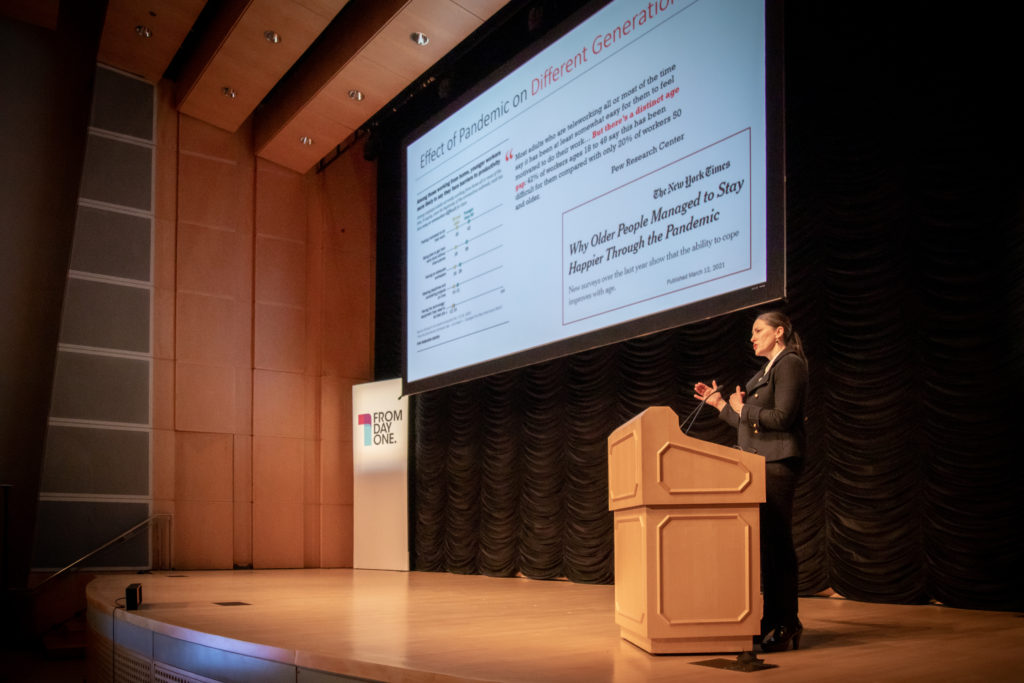How Different Generations Responded to the Pandemic and Remote Work


While the switch to remote work was stressful for most employees, people over the age of 50 tended to handle pandemic stresses and remote work much better than their younger coworkers, according to Heather Tinsley-Fix, AARP senior advisor of Financial Resilience.
Research from the Stanford Center of Longevity and Nintex, a process-management and workflow-automation company, found that older people had more positive emotions throughout the day and were less likely to experience a change to their personal wellness by working remotely during the pandemic, “despite the fact that both groups reported the same levels of stress,” Tinsley-Fix said in a presentation at From Day One’s May conference in Washington, D.C.
Tinsley-Fix theorized that with age comes the development of coping skills and resilience. “The older we get, the more we’ve weathered, the more we know our own skills to cope with difficult things or in some cases, with once-in-a-lifetime things like the pandemic. While we experienced the same amount of stress or are facing some of the same challenges, we have developed more of those skills to deal with it, and so we report higher levels of happiness or ability to concentrate.”
Getting Back to the Office
In terms of returning to work, there is also a generational gap, Tinsley-Fix noted. The Conference Board’s Return to Work Survey found that while 43% of Baby Boomers are comfortable returning to the office, only 24% of millennials said they were. In addition, 55% of millennials said they don’t see a need to return to the office at all, while only 35% of Baby Boomer respondents felt the same.
That “return to the office” gap also becomes more apparent when comparing the attitudes of those in leadership positions versus non-leadership positions. Among the CEOs surveyed, 66% said they were comfortable returning to the office, while only 23% of individual contributors felt comfortable returning. “So again, there’s this interesting tension between not only generationally what people expect and want, but also between leadership and individual contributors,” Tinsley-Fix said.

But while there is an expectation that going forward, the work environment will be a mix of in-person, remote and hybrid—according to a PwC Next in Work survey, only 19% of companies think their workforce will be all in-person—younger generations, in particular Generation Z, has struggled the most in the all-remote environment.
“They’re more likely to say they’re struggling to speak up in meetings, to bring new ideas to the table and to just cope in general,” Tinsley-Fix said, while noting that some Gen Z workers started their careers in a fully remote-work environment. “I can understand how that would be difficult to not have met any of my colleagues in person and to try to maintain a presence in meetings. The younger generations are needing just a little bit of extra help to stay engaged, to feel part of the fabric and culture of your organizations,” she explained.
In terms of engagement, productivity and work-life balance, most of the data suggests that working remotely has been positive for employees. According to research from The University of Chicago Booth School of Business, 40% of workers reported they were more productive at home during the pandemic than they had been when in the office and on average, people’s productivity at home was about 7% higher than they expected. “So we know that productivity did not take a hit when we moved into the remote environment, which is very good thing, obviously for all of our organizations, but also paved the way for this new mode we’re entering now,” Tinsley-Fix said.
Office Space of the Future
All of this data will impact what offices look like in the future, moving from an office-centric environment to a more human-centric one, Tinsley-Fix theorized. She pointed to recent research by Gartner, which categorizes four types of arrangements: working together-together, working together-apart, working alone-together and working alone-apart. “Previous to the pandemic, you would think there are telecommuters and there are people in the office and that’s the only axis: in or out. But I like this new way of looking at it that Gartner proposes,” she said.
“Even though we’ve gone virtual, and went virtual sort of overnight, we were still thinking of a virtual office environment, which leads to expectations of things like consistency of schedule, serendipitous meetings, visibility into what people’s schedules are like and what they’re doing at any given time during the day,” she said. “What we really need to accomplish is a shift in thinking towards a more human-centric way of viewing work or the office. We’re not really thinking of the office as a physical place anymore.”
Editor’s Note: From Day One thanks its partner AARP for supporting this Thought Leadership Spotlight.
Sheryll Poe is a freelance journalist based in Alexandria, Va.
The From Day One Newsletter is a monthly roundup of articles, features, and editorials on innovative ways for companies to forge stronger relationships with their employees, customers, and communities.